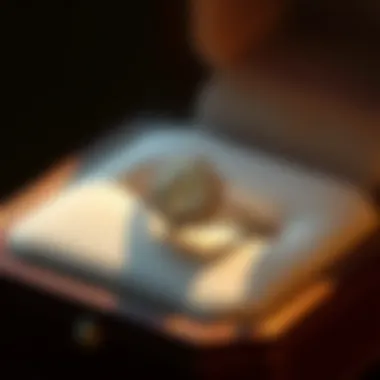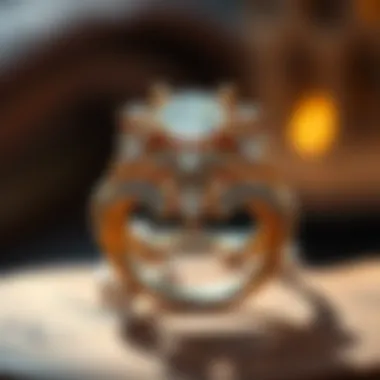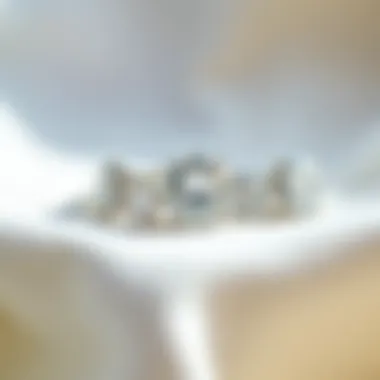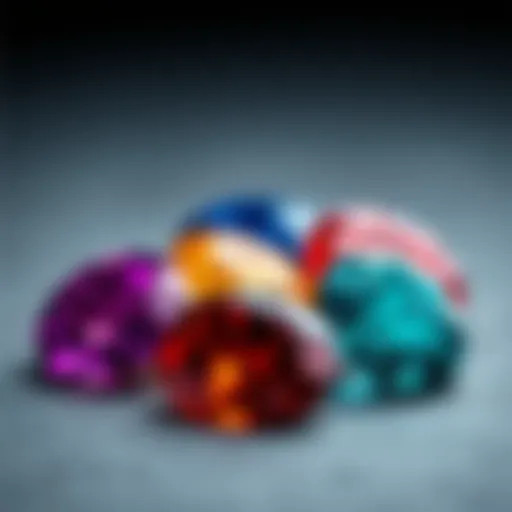Understanding Engagement Ring Spending: Key Factors


Intro
When embarking on the journey to purchase an engagement ring, a myriad of emotional and financial factors come into play. What is considered a normal expenditure? This question is paramount for any prospective buyer and can often lead to second-guessing and confusion.
Historically, spending on engagement rings has been influenced by societal norms and commercial pressures. What used to be an intimate gesture has turned into a symbolic financial commitment, often determined by vague guidelines rather than personal circumstances. As we navigate the seas of choices, it’s crucial to understand that the ‘average’ spending can shift based on a variety of aspects.
In this article, we’ll peel back the layers surrounding this topic. We’ll examine cultural expectations, personal preferences, and even economic conditions that shape decisions. Furthermore, we will dive deep into historical trends and critically evaluate the notion of spending three months' salary, a belief that many still hold onto today. By the end of our exploration, readers should feel empowered with clearer insight into what constitutes a reasonable budget for this significant purchase.
Gemstone Overview
Engagement rings often feature diamonds, yet the world of gemstones is vast and rich with options. When selecting a gemstone—whether it be a diamond, sapphire, or emerald—understanding its distinct characteristics is essential.
Description of the Gemstone
Diamonds, known for their brilliance and durability, often symbolize eternal love and commitment. However, other gemstones, such as sapphires and rubies, also carry their share of history and meaning. For instance, sapphires are not only stunning with their rich blue hues; they signify wisdom and nobility. Each gemstone offers a unique story and significance, paving the way for personal choices based on taste and values.
Physical Properties
The physical properties of these gemstones can vary widely:
- Diamonds: Composed of carbon, they rate a perfect ten on the Mohs scale of hardness, making them exceptionally durable.
- Sapphires: Also quite hard, sapphires score a nine on the Mohs scale, often available in diverse colors.
- Emeralds: While beautiful, they rank lower in hardness (around 7.5 to 8), which makes them more prone to scratches compared to diamonds.
Knowing the physical traits of a gemstone can heavily influence its longevity and suitability for daily wear.
Healing Properties
While traditionally seen as mere adornments, many believe that gemstones carry healing properties. Each type of gemstone is thought to hold metaphysical attributes that enhance emotional and spiritual well-being.
Metaphysical Attributes
- Diamonds: Considered to channel clarity and purity, they’re often associated with deepening trust and intimacy.
- Sapphires: Said to bring peace of mind and promote self-expression, sapphires can aid in mental clarity.
- Emeralds: Often regarded as symbols of rebirth, these stones are believed to foster rejuvenation and unity in relationships.
Common Uses in Holistic Practices
Many turn to gemstones in holistic practices, integrating them into daily life through meditation, jewelry, or even elixirs. Their powerful energy is said to rejuvenate the spirit and encourage positive emotional shifts. As such, choosing a gemstone for an engagement ring might transcend mere aesthetics—reflecting a deeper connection and personal belief system.
As our analysis unfolds, we'll delve into how all these factors interplay with the decision-making process regarding spending on engagement rings, ultimately helping readers define what feels normal for their unique situation.
Cultural Perspectives on Engagement Ring Spending
When it comes to purchasing an engagement ring, cultural perspectives play a key role in shaping what is deemed a reasonable expenditure. This topic is not just about the bucks spent but encapsulates values, traditions, and expectations within various societies. The significance of an engagement ring transcends mere materialism and taps into deeper relational meanings. This context allows us to appreciate why some people might fork out a hefty sum while others adhere to a more modest approach. Understanding these cultural undercurrents can assist buyers in making decisions that respect their heritage and personal values without going broke in the process.
Historic Trends in Engagement Ring Costs
Historically, the cost of engagement rings has seen a rollercoaster of changes. Back in the day, for instance during the Victorian era, engagement rings often held a modest price tag and frequently featured simple designs. It was considered a sign of affection rather than a showcase of wealth. However, fast forward to the early 20th century, marketing campaigns began to shift perceptions drastically. The advent of De Beers’ "A Diamond is Forever" campaign in the 1940s firmly planted the idea that not only should one buy a ring, but also invest in a significant one. This led to skyrocketing prices as diamond sales peaked, establishing a standard that many still follow today. In current context, buying a ring worth two or three months' salary became a popular guideline, although it's worth noting that many people choose to deviate from this norm based on personal circumstances or preferences.
Global Variations in Expectations
Different cultures around the world recognize varying expectations when it comes to engagement rings. In some cultures, like in parts of South Asia, it is customary for the bride's family to provide substantial jewelry during the wedding, shifting financial responsibilities. In stark contrast, Western cultures typically attribute the financial load to the groom. This global patchwork of expectations can lead to confusion or stress for couples navigating their future together.
For instance, in places like Japan, an engagement ring may not even be necessary, with some couples opting for a wedding band instead. In contrast, lavish displays are quite common within some Middle Eastern cultures, where the ring's value might be indicative of social status. Ultimately, engagement ring prices vary wildly not just on a personal level but also along cultural lines, creating a tapestry of spending practices that reflects deeply-rooted traditions and societal norms.
The Origins of the Engagement Ring Tradition
Engagement rings hold a unique status in our societal rituals, often symbolizing love, commitment, and partnership. Understanding their origins lays the foundation for comprehending why certain spending norms have solidified. It’s like peeling an onion; every layer uncovers a deeper meaning, a connection that spans across generations and cultures. This exploration dives into the historical significance and connotations attached to engagement rings, illustrating how they echo personal values and societal expectations.
Symbolism Throughout History
Across centuries, engagement rings have morphed from simple tokens to elaborate pieces of jewelry, replete with meaning. Initially, in ancient cultures like the Egyptians, rings were made from reeds or braided sinew and given as seals of commitment. It was more about practicality than aesthetics. They believed that the circle represented eternity, with no beginning and no end. As time went on, the Romans adopted this custom, introducing metal bands to signify engagement.
- Medieval Europe: Here, the tradition started to take root among the nobility. Rings often held gemstones, symbolizing specific virtues, such as fidelity and love.
- Victorian Era: The engagement ring became a status symbol with the introduction of ornate designs. Gemstones such as diamonds were seen as representations of purity.
- Modern Times: Today, the engagement ring is a widespread cultural norm that transcends class structures and geographies.
Moreover, the transition from simple rings to elaborate jewelry reflects shifting values around love and partnership. As more people began to have access to these symbols of commitment, the growing significance of engagement rings became evident. It brings to light the importance of personal connection—every ring tells a story, whether it’s a cherished heirloom or a modern classic purchased at a contemporary jeweler.
The Role of Diamonds and Other Gemstones
Diamonds, in particular, have carved a special niche in the engagement ring market, thanks in no small part to aggressive marketing campaigns that began in the 20th century. The paradigm shift to favor diamonds over other stones wasn't simply about rarity but also ingrained emotional resonance. The phrase "a diamond is forever" encapsulates the notion that marriage is a lifelong commitment, thus giving rise to the belief that only the hardest substance on Earth could symbolize such steadfastness.


Other gemstones, like sapphires, emeralds, and rubies, also have a longstanding history in engagement rings but often take a backseat to diamonds.
- Sapphires: Associated with wisdom and nobility, they hold a special place in royal engagements.
- Emeralds: Historically, they represent rebirth and fertility, often favored by famous personalities.
- Rubies: These fiery stones embody passion and love, making them a daring choice in today's market.
Interestingly, the material choice of an engagement ring says a lot about personal and cultural values. While some may lean towards traditional diamond rings reflecting societal norms, others might choose more unusual stones that tell a unique story.
"A ring is more than just a piece of jewelry; it encapsulates memories, promises, and dreams between partners."
In essence, the conceptual journey of engagement rings has been as dynamic as human relationships themselves. Understanding this tradition offers valuable context for evaluating associated expenses. As they're deeply rooted in symbolism and personal significance, the choice of materials and styles can greatly influence what one perceives as a 'normal' expenditure.
Establishing this foundation aids in demystifying both the cultural pressures and financial expectations surrounding engagement rings today. A thorough grasp of history not only enriches the selection process but also adds a layer of appreciation for the importance these rings hold in the journey of love and partnership.
Current Trends in Ring Pricing
Understanding the trends in ring pricing is essential in grasping what one might expect when purchasing an engagement ring today. It's not just about the glimmer of diamonds or sparkle of colored gemstones; the current landscape involves fluctuating market conditions, consumer preferences, and cultural shifts.
Factors Influencing Market Prices
Several elements play a significant role in the pricing of engagement rings. A few of the more prominent factors worth noting include:
- Supply and Demand: The availability of gemstones, especially rare ones, directly impacts their price. For instance, if a particular gem, like Morganite, suddenly spikes in popularity, its price might climb faster than a squirrel up a tree when it's startled.
- Economic Climate: During economic hardships, consumers often tighten their purse strings. This can lead to a dip in luxury item prices. Conversely, when the economy is booming, spending flies high, often driving prices up.
- Retail Markup: Jewelers don’t operate on a flat fee. The price you see includes a markup that varies widely by retailer. High-end boutiques might make a piece cost more simply due to branding, whereas online retailers often provide competitive prices.
- Certification Costs: Rings that come with lab certifications regarding their quality—like GIA or AGS—tend to be more expensive. This is a consideration for buyers who value transparency and authenticity.
- Trends in Style: Jewelry trends evolve, and what’s considered fashionable can shift just like the wind changes direction. Current trends show a rising interest in unique, vintage-inspired rings and alternative gemstones, impacting the traditional diamond’s standing.
"Luxury is not just a price tag; it’s often a narrative revealed by the choices you make while selecting your ring."
Emerging Alternatives and Their Costs
As consumers become more conscious of sustainability and personal expression, alternative engagement ring options have emerged on the scene. Buyers are diversifying their choices beyond the classic diamond, often considering:
- Lab-Created Diamonds: These stones can cost 20%-40% less than their natural counterparts while offering the same sparkle. Plus, they often appeal to eco-conscious shoppers.
- Alternative Gemstones: From sapphires to moissanite, non-diamond stones are gaining traction. Their prices can range significantly—while a pink sapphire may run a few hundred dollars, a large royal blue sapphire can command thousands.
- Vintage Rings: An excellent way to sport a unique piece is looking into antique or pre-owned rings. Prices here can vary based on age, condition, and history, sometimes leading to surprising deals.
- Custom Designs: More couples are opting for bespoke rings to reflect their individual style. While this can be pricier upfront, it enables one to prioritize personal significance over retail trends.
- Ethical Sources: Engagement rings sourced from conflict-free zones or produced with fair-trade practices can also carry a higher price, but they offer peace of mind for those concerned about sourcing issues.
Evaluating the Three-Month Salary Rule
In the conversation around engagement rings, the three-month salary rule often pops up like a bad penny. This guideline suggests that a buyer should spend an amount equivalent to three months’ salary on an engagement ring. Though it’s frequently cited, its origins and relevance are more complex than simple math.
Understanding this rule is crucial because it shapes expectations for many couples. Financial decisions tied to wedding planning are often tied to societal norms. Scrutinizing the three-month salary guideline not only helps couples make informed decisions but also sheds light on how personal financial circumstances vary drastically.
Origins of the Concept
The roots of the three-month salary rule can be traced back to the advertising campaigns of the diamond industry, particularly in the mid-20th century. A notable figure in this is the De Beers company, which, through its shrewd marketing, sought to associate diamonds with not only love but also commitment and financial investment. Back in the 1930s, they launched a campaign that contended that a ring’s cost should serve as a reflection of one’s affections. This was a clever play on the notion that expensive gifts symbolized deep love.
Many couples latched onto this idea decades later, unaware of its fabricated beginnings. Essentially, what started as a marketing tactic took on a life of its own, morphing into a seemingly universal guideline, despite its artificial nature. This makes it all the more vital to peel back the layers and look closely at whether following this rule makes sense in today’s financial ecosystem.
Critiques and Alternatives
Critiques of the three-month salary rule abound, and they raise valid points worth consideration.
- Individual Circumstances: Everyone’s financial situation is unique. For some, three months’ salary could translate into thousands of dollars, whereas for others, it could represent a significant burden.
- Value vs. Cost: Many individuals argue that the worth of a ring should correlate with personal values and not societal expectations. How a diamond makes one feel matters more than the price tag.
- Alternative Spending Models: Some potential buyers now lean towards setting a budget that genuinely reflects their financial health rather than adhering to outdated standards. This can mean spending one month’s salary, or in some cases, opting for simpler, yet equally meaningful pieces, like vintage rings or alternative gemstones.
The most valuable thing about an engagement ring is the commitment between partners, not the dollar signs attached to it.
Critically examining the three-month salary rule allows couples to break free from commercial pressures and tailor their spending to match genuine sentiments and practical realities. By evaluating financial abilities and shared values, they can decide what truly reflects their love, thus making the engagement ring an emblem of their relationship rather than a mere financial commitment.
Determining Your Personal Budget
Setting a personal budget for an engagement ring is not just about numbers; it’s a holistic approach that intertwines your values, financial status, and relationship expectations. An engagement ring is a symbolic and emotional investment, so understanding how much you want to spend can help you avoid overspending and feeling regret later.
Budgeting doesn’t merely reflect one’s financial standing; it indicates a conscious choice to reflect your individual relationship values. First off, awareness of your financial priorities is crucial. Are you saving for a house, a new car, or perhaps a dream vacation? All these factors should nestle into your budgetary considerations. Addressing these priorities allows you to assess how the engagement ring fits into the broader picture of your life goals.
Evaluating Financial Priorities
When looking through financial priorities, one must approach it methodically. Begin with a full view of your income versus your living expenses. Create a list detailing essential expenses, like rent, groceries, and utilities, versus discretionary spending such as dining out and entertainment.
- Essential Expenses
- Discretionary Spending
- Rent/Mortgage
- Utilities
- Groceries
- Insurance
- Dining Out
- Hobbies
- Shopping
This comparative analysis not only sheds light on how much disposable income you have, but also on how far you can stretch without exhausting your finances. Although some folks resort to the arbitrary three-month salary rule, it may not align with everyone’s real-life example. Your priorities might allow for more or less, depending on your financial health without jeopardizing your lifestyle. This leads to a more authentic purchasing decision — one that resonates with who you are.


Discounts and Deals: Are They Worth It?
When contemplating the possible purchase of an engagement ring, the allure of discounts or deals can often be tempting. There’s a true art to discerning whether a deal is worthy or merely smoke and mirrors. If a store advertises a 20% discount on their rings during a holiday sale, ask yourself: is the quality still there? Or are you just buying into a marketing hype?
Before making any moves, it pays to understand what constitutes quality in gemstones and metals. Research the retailer's reputation by diving into customer reviews, or join conversations on platforms like Reddit or Facebook to gauge others' experiences. You need to ensure that the deal doesn’t come at the cost of quality blindness. Furthermore, be on the lookout for seasonal sales which might offer valuable savings without compromising craftsmanship.
Of course, applying timed discounts to your overall budget can provide significant relief, while allowing you to remain within your set financial boundaries. However, don’t let a deal blind you to the essentials of what you truly want. Only buy if it aligns with your preferences and values; otherwise, one might be left feeling buyer’s remorse.
As you discern between needs and wants, remember: the best deals are those that enhance value rather than simply reduce cost.
The combination of evaluating your financial priorities and knowing how to navigate deals largely contributes to making an informed decision. Ultimately, it’s about finding that sweet spot where personal significance meets prudent spending.
Understanding Different Types of Engagement Rings
When it comes to engagement rings, the selection process can feel like trying to find a needle in a haystack. Understanding the different types of engagement rings is crucial not just for making a purchase, but also for ensuring that the ring aligns with personal taste as well as the emotional significance attached to it. This section delves into the various styles and considerations, which can greatly affect the buying decision, and ultimately, the experience surrounding the proposal.
Traditional vs. Modern Styles
The divide between traditional and modern styles is a significant starting point when exploring engagement rings. Traditional rings typically feature a solitaire diamond or a classic three-stone setting, each representing different aspects of love and commitment. These designs speak to the sentimentality of the occasion, often having a timeless appeal. Many view this style as a rite of passage; it’s common to hear stories from older generations about how their grandmother's ring was passed down through the family. This deep-rooted connection makes traditional rings often feel like they carry a piece of history.
On the other hand, modern styles have taken significant leaps that extend creative boundaries. From unique gemstones like sapphires to unconventional cuts like pears and ovals, modern designs are often more about personal expression. There’s a sense of freedom that comes with these rings—couples are not bound to norms and can truly reflect their individuality. A popular trend nowadays is customizing rings, thus allowing partners to engage in the decision-making process together. This leads to a ring that tells a mutual love story.
It is essential to factor in lifestyle as well. A person who leads an active life might prefer a lower-profile ring to avoid snagging, while another may favor a lavish piece that catches eyes at every turn. Therefore, understanding these styles aids immensely in not only making a decision but also in being practical while considering aesthetics.
Ethical Considerations in Gemstone Selection
In recent years, ethical considerations have gained ground in the realm of jewelry, including engagement rings. The source of gemstones has come under scrutiny, and many buyers are increasingly conscious of where their diamonds or other gems originate. Natural diamonds, while stunning, often raise questions about conflict diamonds and the impact of mining practices on communities and environments.
This has led to a surge in popularity for ethically sourced stones. Partners might choose lab-created diamonds or gemstones that carry certifications for responsible mining. This choice speaks volumes about their values, showcasing a commitment to not just personal love but to ethical standards as well. Choosing an ethically sourced stone might seem like a small detail, but it adds to the emotional weight of the purchase, knowing that it contributes positively to the world.
Furthermore, beyond just sourcing, consumers are increasingly looking at brand practices. Companies that promote sustainable practices or give back to communities through their business models tend to resonate more with individuals today. Knowing that a purchase aligns with personal values can heighten the significance of the ring itself.
"The ring should not only sparkle; it should carry a story that is meaningful on all levels."
In summary, gaining an understanding of the various types of engagement rings, be it traditional or modern styles and ethical considerations, is pivotal in making that purchase. It allows couples to choose rings that symbolize their unique journey while respecting their principle viewpoints. With the right knowledge, couples won't just be spending money; they will be investing in a tangible piece of their mutual love story.
The Emotional Aspect of Ring Purchases
When it comes to buying an engagement ring, emotions are as crucial as the financial considerations. Many may ponder over dollar signs, but the truth is, that the heart of the matter often weighs heavier than the wallet. For many, this ring is more than just a piece of jewelry; it's a promise, a commitment, and a symbol that carries years of love and loyalty. This section aims to explore why the emotional facets are integral in assessing what is 'normal' to spend on such a significant purchase.
Significance Beyond Financial Value
First and foremost, one must recognize that the significance of an engagement ring extends well beyond its price tag. While some might grasp at the idea that a more expensive ring reflects a deeper love, this isn't always the case. The emotional value tied to the ring often arises from personal stories, memories, and shared moments rather than the sparkling numbers on a receipt. A simple band, passed down through generations, can evoke a sense of heritage that no diamond's cut can replicate.
Consider this: a couple might decide to invest in an intricately designed ring. Just as likely, they could prefer a minimalist style, perhaps one that symbolizes their unique relationship. It becomes evident that the meaning behind the purchase often trumps the financial side, wrapping the piece in layers of personal history. Paying attention to what resonates with both partners plays a paramount role in defining the true worth of the ring.
The emotional connection you have with your engagement ring is a treasure far richer than anything that sparkles.
Personal Stories and Their Impact
Next, it's vital to reflect on how personal narratives influence spending decisions. Each couple has a unique story — from the cozy coffee shop where they first met to the spontaneous romantic getaway that sealed the deal. These shared experiences can steer the choice of an engagement ring toward something that mirrors those very moments. For instance, rings inspired by the location of their first date, or gemstones that hold significance, add layers to the choice that money alone can't account for.
Furthermore, take note of how personal stories often inform the expectations of the individuals involved. For some, the legacy of a family heirloom might dictate a different path—after all, isn't there a certain charm in continuing a tradition that has lasted decades? Others might shy away from the extravagance seen in social media portrayals and choose instead to forge their own path, opting for simplicity over expense.
Through conversations and explorations of these stories, couples can build a foundation that guides their choices.
Tips for Purchasing Engagement Rings
Purchasing an engagement ring can feel like a mountain to climb for many. For a lot of folks, this isn't merely a transaction; it symbolizes a pivotal moment in their lives. The tips to keep in mind during this journey not only make the process smoother but also more meaningful. First and foremost, knowing where to splurge and where to save can totally tilt the balance in your favor. Also, understanding key aspects like quality over quantity when it comes to stones can lead to making an educated choice that you won't regret later.
Before starting the hunt for the perfect ring, evaluat your personal preferences and financial situation. This sets the stage for a much more relaxed environment to explore options and make decisions. Also, it might be wise to consider the opinions and styles of your partner, especially if you want to ensure the ring resonates well with them. The research you do here translates directly into a rewarding purchase, instead of an exercise in stress.
Here's a concise overview of what you'll encounter:
- The Buying Environment: Local shops or online sellers, which works best for you?
- Evaluating Quality: What exactly goes into determining the value of a gemstone?
- Negotiating Prices: Knowing how to haggle could save you some serious bucks.
"The price of an engagement ring is often not just about the ring but symbolizes a commitment and shows love that can't be measured in dollars."
When armed with the right tips, you're less likely to feel overwhelmed and more inclined to make a choice that feels right for both your budget and romantic intentions.


Where to Buy: Local vs. Online
As you step into the world of engagement ring shopping, one of the first choices you must make is whether to go local or turn to the online marketplace. Each avenue has its own advantages, and it might all boil down to personal preference.
Local Jewelers
When you shop locally, you open the door for personal interaction. Local jewelers often provide excellent customer service and after-sales support. Browsing their collections in-store allows you to physically inspect the rings, giving a better feel for the quality, weight and overall aesthetics. Plus, being able to ask questions and receive immediate answers can ease the nerves of this critical purchase. It’s an experience that a screen can’t replicate.
Online Shopping
Shopping online can be a game-changer. You might find a broader selection and often better prices due to lower overhead costs from online retailers. Research shows that online rings often give you access to higher-quality gems and customizable options. The only caveat? You won’t have the chance to see the product before it arrives. It's crucial to choose reputable websites and read customer reviews for insights. Moreover, many online retailers offer easy returns, which can provide peace of mind.
Bottom Line
Ultimately, the choice of local vs. online boils down to your comfort level. Both choices have pros and cons—whether it’s the tactile experience of seeing and feeling the ring or the variety of options available online. Make sure to visit multiple sources to compare prices and quality.
How to Compare Gemstone Quality
Quality is king when it comes to gemstones, and understanding how to assess it is essential. Here’s where it gets interesting—you have several factors that play a part in determining the quality of a gemstone.
The Four Cs
- Cut: This greatly influences how well the stone reflects light. A masterfully cut diamond is sparkly and beautiful.
- Color: From colorless diamonds to those with a hue, grading ranges from D (colorless) to Z (light yellow). The less color, generally the better for diamonds.
- Clarity: This reflects the internal aspects of the stone. Fewer flaws generally mean higher value.
- Carat: This measures the size of the stone. Bigger isn’t always better; it depends on the other Cs.
Other Factors
- Origin: Some gemstones are renowned for their origins, like Kashmir sapphires or Burmese rubies, which can influence pricing significantly.
- Treatment: Many stones undergo treatments to improve their look. Knowing if a stone has been treated or not is essential in evaluating its true value.
When comparing the quality of gemstones, rely on reputable sources for your assessments. A knowledgeable jeweler can provide insights that go a long way in helping you make an informed decision. Conduct thorough research, and never feel shy to ask questions. A well-informed buyer is always in a better position to negotiate prices and walk away with a gem that not only looks good but also holds real value.
Post-Purchase Considerations
When it comes to purchasing an engagement ring, most attention goes to the selection process and the price tag attached. However, once you've made that important purchase, post-purchase considerations can play an equally critical role in safeguarding your investment and ensuring your ring retains its beauty and value in the years to come.
Insurance for Your Ring
Buying insurance for your engagement ring can be a wise move, providing peace of mind against loss, theft, or unexpected damage. While insurance typically isn’t mandated, treating your ring as the valuable asset it is can protect you financially.
Here are some key factors to consider regarding insurance:
- Types of Policies: You can either add your ring to an existing homeowner’s policy or purchase separate jewelry insurance. The latter often covers more specific incidents, ensuring more comprehensive protection.
- Coverage Amount: It’s crucial to insure your ring for its complete value. This generally involves getting an appraisal from a certified gemologist to determine its current market worth. You don’t want to find yourself underinsured, covering only a fraction of what the ring is truly worth.
- Deductibles and Premiums: Familiarize yourself with the terms of your coverage. A lower premium might sound appealing at first, but it may come with a higher deductible. Evaluate how much you'd be willing to pay out-of-pocket in case of a claim.
"Purchasing insurance doesn’t only protect a monetary investment; it also provides emotional security."
Maintenance and Valuation Over Time
Caring for your engagement ring is essential for preserving its allure and value. Like any investment, it requires regular attention to ensure it stays in top shape.
Here’s a rundown on maintenance aspects to keep your ring sparkling:
- Regular Cleaning: Dirt and oils can build up over time, dulling the shine of gemstones. At home, you can use a gentle soap solution and soft brush to regularly clean your ring. For a deeper clean, consider professional services at a jeweler.
- Periodic Inspections: Schedule regular check-ups with a jeweler. They can check for loose stones, wear on the setting, and general wear and tear. Just as cars need tune-ups, rings need attention too!
- Value Reevaluation: It’s a smart move to have your ring appraised every few years. Fluctuations in market prices can affect its value. Should the time come for you to sell or upgrade, having an accurate valuation ensures you’re informed about what your ring is worth, avoiding any nasty surprises.
By being proactive about insurance and maintenance, you not only protect your financial investment but also preserve the emotional significance behind the ring. Whether it's the shiny diamond or the intricate design, regular care helps keep the magic alive.
Ending: Finding Balance in Spending
Determining how much to spend on an engagement ring is a significant decision with a blend of financial and emotional implications. The journey through this financial maze requires careful calibration, as it isn’t solely about the numbers on a price tag, but more about the personal significance of the ring and the relationship it represents. Balancing what is deemed normal with one’s own financial reality is essential; it strengthens the commitment the ring symbolizes while maintaining a healthy respect for personal finances.
In this article, we’ve dissected various elements that influence the costs associated with engagement rings. From cultural expectations and historical trends to current market fluctuations and individual financial priorities, each facet contributes to a broader understanding of what constitutes a reasonable expense. Here are some key considerations to keep in mind as you navigate this terrain:
- Personal Circumstances: Your unique financial situation should drive your decisions. No need to keep up with anyone else; your priorities are what matter.
- Cultural Context: Recognize that spending norms vary widely based on cultural backgrounds. What’s traditional in one culture might not hold the same weight in another.
- Emotional Value vs. Price Tag: Focus on the emotional significance of the ring over its monetary value. A meaningful choice can transcend the idea of extravagant spending.
Ultimately, finding a balance that respects both emotional connections and financial realities can lead to a satisfying purchase, one that resonates personally and socially.
Personalizing Your Choice
When it comes to buying an engagement ring, personalizing your selection is not just a matter of aesthetics—it's about embedding your unique love story into a tangible form. It’s crucial to consider several aspects that reflect your relationship:
- Style and Preference: Know what you or your partner enjoy. This can be anything from a vintage design to a sleek modern look. Custom rings or unique gemstone cuts can express individuality in ways that standard options may not.
- Gemstone Choice: While diamonds are traditionally popular, other gemstones like sapphires or emeralds may hold more significance for different couples. This can also tie into personal values, such as embracing ethical sourcing.
- Family Heirlooms: Incorporating a family stone or a setting can provide rich history and emotional attachment, making the ring a true representation of your lineage and connection.
Ultimately, the aim is to craft a ring that tells your story. This personalized approach can enhance the significance of the ring, reminding the wearer of the love it represents every time they catch a glimpse of it.
Reflecting on Individual Values
Understanding and aligning spending on an engagement ring with one's values can lure clarity and peace of mind in an otherwise overwhelming process. Every buyer has their unique set of principles that can influence their choices. Take a moment to reflect on what truly matters:
- Financial Responsibility: Consider what fits within your budget without compromising essential expenses like savings or living costs. Financial responsibility can serve as a sturdy foundation for any relationship.
- Ethics in Jewelry: More buyers today are leaning towards ethically sourced materials. What might have been a rare concern is now becoming prominent, and supporting ethical practices demonstrates values that resonate with a broader cause.
- Long-Term Investment: Consider how the ring serves over time, both physically as a piece of jewelry and symbolically in your life together. Reflect on whether you view the ring as a status symbol or an embodiment of love.
By contemplating these values, you not only make a purchase that resonates with your beliefs but also ensures a stronger bond that aligns with the vision you both hold for your partnership.
"The ring is not just a piece of jewelry; it's a promise, a commitment, and a reflection of values carried in it. "







